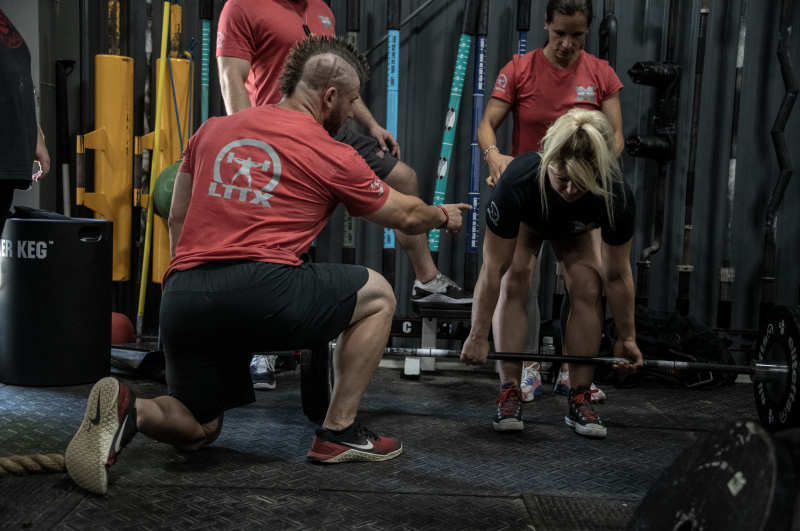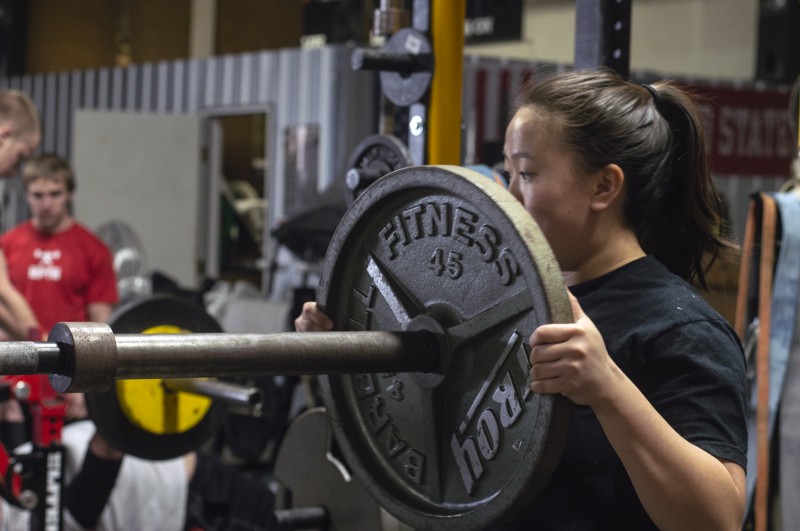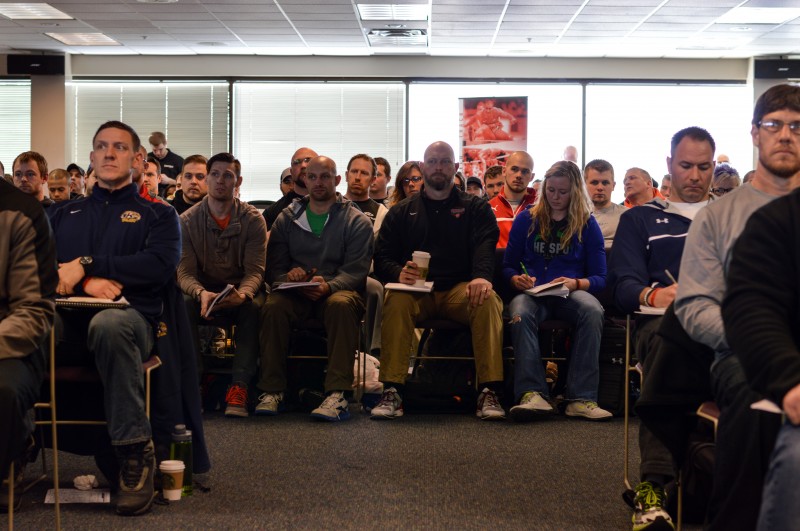
There are many things that can be done to improve our situation in collegiate athletics and to advance our profession. Some of these things are rather simple, such as starting to act like professionals, especially when we are in a setting which we are more visible than in the weight room, or establishing a common title that is used at all universities.
However, some problems require a much more in-depth and time-consuming process to achieve. Revamping our current education and certification requirements is likely a long-term process but a necessity to establish our role and our relevance in the collegiate setting.
RECENT: Strength and Conditioning is Failing: Certifications and Qualifications
The education of administrators and sports coaches to encourage the acknowledgment, understanding, and acceptance of our role and the importance of actual strength coaches conducting all strength and conditioning activities is something that will likely take several decades to accomplish. But we have to start somewhere, and providing problems with no solutions does not do anything to bring about real change.
There Can Only Be One
The United States has only one president. Businesses have only one CEO. A school has only one principal. Professional sporting organizations have only one commissioner. So, why are we compelled to have two organizations trying to lead our way?
Two organizations create conflict and display weakness rather than strength. There can be only one voice to which the NCAA is listening.

The NSCA has been around the longest and has the most recognition to those outside of strength and conditioning. Therefore, the NSCA should be the organization we rally around to achieve the results we need.
Unfortunately, the NSCA has gotten too big and serves too broad of a field. Solving this problem does not mean mainstreaming the focus of the organization. To the contrary, growth is good and essential. However, it is essential that a branch is created specifically to serve collegiate strength and conditioning. Collegiate strength and conditioning is too big and faces such unique issues, it needs its own branch to specifically serve our needs.
Mandatory Certification
Certifications are “mandatory.” And those quotes are the problem. It is time for the NCAA to require all schools at all levels of athletics to hire certified strength coaches. The current requirements allow far too much leeway, allowing schools to get around the rules. It is time for one single certification to be the only allowable certification in collegiate athletics.
The NSCA needs to continue lobbying the NCAA until legislation is passed that requires a specific certification to be held, as well as some sort of accountability so that schools know the credentials of the coaches they are hiring.
A New Certification Model
The statement by Bob Bowlsby (Barnett) concerning the strength of our certifications tells us we need to strengthen our certification. If we want to hold a certification that actually means something, we need to develop a strong certification that is required by the NCAA.
While the CSCS has become weak by today’s standards, it would be foolish to abandon this certification. Abandonment of this well-established certification would only take us backward. Creating new certifications shows instability and weakens the perceived quality of the certification. Instead, it needs to be strengthened to a meaningful level. The CSCS needs to have designations to reflect the career choice of the individual taking the exam. It makes no sense for a researcher and a coach to be taking the same test. Their careers are quite different, and that should be reflected by their certification. The test itself, as well as the credentials provided, should demonstrate the specificity of coaching.
RELATED: A Fair Assessment of the CSCCa and NSCA
While I am not promoting the CSCCa, I do feel their certification model provides solid groundwork from which we can build a strong certification that actually means something. The certification not only needs to test book knowledge but also knowledge of technique and coaching ability. The certification needs to require an internship with a minimum number of hours. The internship must be structured in a manner that we would know those completing it would have gone through intensive training in coaching in a real-world setting.
There can only be one certification, and it must contain a very strong educational component of both standardized questions and answers along with a written component that includes situational-type questions with both components being designed in a way to show that we have a high level of knowledge of both the scientific and practical aspects of sports preparation.
Second, there must be a programming component to show that we can adequately construct an annual plan detailing logical intensity, volume, and exercise progression of all components of strength and conditioning, including strength, power, speed, agility, conditioning, and flexibility.
Additionally, there must be a practicum or internship requirement with specific requirements of the host institution that must be met in order to be considered a qualifying internship. Handing out supplements and cleaning equipment does not prepare coaches. There must be a coaching component. You cannot be a strength and conditioning coach without having the ability to actually coach.
A related degree must be required to obtain the certification. Simply having any bachelor’s degree can no longer be acceptable. We need to create a list of acceptable majors, and all degrees must be subject to review in order to assess relevancy before certification can be granted. The creation of a new degree plan in sports science would address all educational requirements.

Maxim Evdokimov © 123rf.com
Strength Coaches Need to Start Wearing Suits
It is of utmost importance that strength coaches begin to move into administrative roles. This has already begun happening and needs to continue. This would allow the opportunity to create a system in which our supervisors and administrators thoroughly understand what we do in our role on a daily basis.
Many administrators at this current time may not understand the importance of these roles and many schools may not be able to fund these positions, but nonetheless, they could have the potential to drastically change many of the problems we face at the ground level.
There are two types of administrative roles that would benefit strength coaches. Neither of these positions should be coaching positions, as that would defeat the purpose.
DON'T FEAR CHANGE: Your Business Can Survive Anything With This
First, there needs to be a position that works at the local (weight room and field) level but is a non-coaching position. This position would be a department director or supervisor that would be directly responsible for all administrative decisions such as purchasing, scheduling, and most importantly, coach education. It would be filled by someone who has extensive coaching experience but also has a desire to progress his career beyond a “floor” coach and would also have the potential to eliminate head strength coach positions while providing better assistance to the entire athletic department.
The department director would be able to provide a direct educational role to young coaches and be able to give instruction and feedback to all coaches on programming, coaching, leadership, etc. This would encourage the growth and development of coaches rather than allowing coaches to go about their job essentially unchecked. The department director would not have any ties to any specific sport nor be fire-able by any sports coach, thus allowing him to be an objective voice when conflict arises between sports coaches and strength coaches. Additionally, it would provide consistency in the department when there is turnover due to coaches leaving, firings, promotions, etc. A person in this position would essentially be a coach of coaches.
The second position needs to be an assistant or associate athletic director position. This position would be a strictly administrative role. Functions of this position would be coordination or possibly supervision of all general preparation and rehab support staff, including strength coaches and athletic trainers, budget management, performance evaluations, and hiring and firing of both strength coaches’ and athlete trainers’ staffs.
This position would allow for someone with intimate knowledge of sports sciences at both the academic and practical levels to provide a direct relationship from the applied positions to administration, from which there is often disconnect. This person would thoroughly understand what is needed to function efficiently and also what the athletic department can effectively provide, and in cases that the department could not adequately provide for, be the primary individual responsible for finding ways to solve problems and provide solutions.

Separate Football and Olympic Sports Staffs
Combined programs do not work. In this day and age, it is not fair to the athletes to have programs that maintain one strength staff to work with every sport, including football. Twenty-first-century football demands too much attention from the strength staff for that staff to effectively work with other teams. There are far too many conflicts that arise when only one staff attempts to handle both roles. These conflicts include scheduling of the weight room, assistant coaches being pulled in too many directions, sports coaches accusing the assistant coaches of running a football program, athletes of Olympic sports getting short-changed, etc.
At the Division I level, schools with football need to have two strength staffs with one staff (five coaches) devoted only to football and a second staff assigned to all other sports, including or excluding basketball. This may require schools to increase staffing but will allow for a setting in which all teams can be treated fairly.
FEATURED GYM: Getting a Bigger and Better Weight Room on a Small-School Budget
This is likely not feasible for smaller schools at the Division IAA, II, and III levels. But at these levels staffing still must be increased.
Mandatory Coach-to-Athlete Ratios
It is not fair to the strength coach or the student-athletes to hire only one coach when there are 300 to 400 athletes in the athletic program. Universities that have large athletic departments must be able and willing to support those teams and athletes. Schools that cannot provide adequate staffing should rethink their desire to have such a large number of teams.
Adequate staffing increases the safety of the student-athletes, allows coaches to cover activities outside of the weight room, allows coaches the time to produce a better quality program, prevents coaches from working excessive hours, and could aid in the prevention of many of the emotional and physical health issues suffered by strength coaches.
The NSCA needs to lobby the NCAA to create legislation requiring schools to provide a minimum number of strength coaches per number of athletes participating in NCAA sports. It is apparent that a small Division II school cannot provide the same staffing as a top tier Division I school, but an effort to properly support the athletes and program must be made. Below are recommendations for coach-to-athlete ratios for Division I and Division II. I cannot make a recommendation on other levels, as I have not spent enough time working there.
- Division I: 1:50 certified coaches to athletes (excludes interns, volunteers, and sports coaches despite certification status)
- Division II: 1:150 certified coaches to athletes (including certified graduate assistants and part-time staff, but excluding interns, volunteers, and sports coaches despite certification status)
Educating Sports Coaches and Athletes
After a conversation with a sports coach, I easily learned the educational level of sports training of coaches. In this conversation, in which the sports coach was attempting to tell me how to manage my own job, he informed me that at times, he doesn’t even know what his team will do for practice until a few hours before practice begins. So much for planning and progression! Unfortunately, this same education level is why sports coaches have no comprehension of the amount of time we, as strength coaches, invest to produce a quality program for their team.
We must try to educate sports coaches. They hold our futures in their hands. This will not be an easy task. Unfortunately, sports coaches are oftentimes close-minded in regards to their opinions of what we should be doing and accomplishing. Convincing them that preparation does not automatically result in more wins and that they should accept accountability for their own wins and losses can be, to say the least, a daunting task. After all, it is much easier for a baseball coach after having a losing season to blame the strength coach for implementing a football program rather than accepting the fact that they did not recruit good enough athletes, did not manage the batting order correctly, or that they overworked their pitchers shoulders, leading to excessive soreness, tendonitis, or other overuse injuries.
BRIDGING THE GAP: Why Sports Coaches Don't Trust Strength Coaches
It is also imperative that we educate our athletes as to what we are trying to accomplish and how the training we are implementing will do that. Future sports coaches are our current athletes that will make the move to coaching after their playing career. Most likely, their formal education is in an unrelated field. So, we must provide them an education that will be of benefit. We don’t have to get into all the complex details, but it is important that they understand the basic whys and hows of the training we are implementing.

The Ultimate Resolution — Education
The solution to improve the current state of affairs would be quite difficult to achieve and likely take decades before an ultimate resolution could take place. This ultimate resolution would be to require a higher level of education of all those involved in the coaching process. At this time, no such program exists.
A program of this nature would need to be created at the collegiate level. An abandonment of the current exercise science and kinesiology programs would be necessary, coupled with the creation of a sports science or sports training degree. This degree would be specific to each sport and would not render the former academic programs obsolete for other areas of exercise, research, nutrition, physical education, etc.
The sports science degree would need to have areas of emphasis including, but not limited to, each particular sport, strength and conditioning, athletic training, psychology, nutrition, and administration. Each emphasis should require a certain degree of overlap of all other areas of emphasis.
For this idea to work, the NCAA would need to require that anyone involved in collegiate athletics obtain this degree. Therefore, playing experience and a driver’s license would no longer be the only requirements for becoming a tennis coach. The tennis coach would now have a Bachelor of Science in sports training with an emphasis in tennis.
The most obvious advantage of majoring in a particular sport would be the achievement of a much higher level of performance in any particular sport. Think about how much more effective a tennis coach could be if 50 percent of their education was devoted to tennis instead of marketing. Within the sport emphasis, all aspects of the sport should be covered. With tennis as an example, classes should be devoted to the biomechanics of tennis, technical aspects of tennis, physiology of tennis, tennis strategy/tactics, coaching strategies, organization of training, means of training (specific, special, and general), practice structure, etc.
The benefit of the emphasis overlap would be two-fold. For the tennis coach in a bigger program, the coach would now have a general understanding of what the strength coach and athletic trainer are trying to accomplish and hopefully prevent the feeling that micromanagement is a necessity. If the tennis coach has a better understanding of the education of a strength coach they may be more willing to let the strength coach do his job.
LISTEN: Table Talk Podcast Clip — Is An Exercise Science Degree Worth It?
Secondly, for programs at lower levels, the sports coaches would have at least enough understanding to reasonably create and implement strength and conditioning practices that would be meaningful and safe in the event that a strength and conditioning coach was not available.
A Charge to Collegiate Strength and Conditioning Professionals
I hope that this article series can provide a sense of direction for us as professionals in the strength and conditioning industry rather than serve as a condemnation. While I am sure there are those who will take offense to these articles, I can assure you that the only intent of these articles is to bring to light the issues that are holding our profession back.
These are our problems. These are not the NCAA’s problems. These are not the problems of the universities and athletic departments of which we are trying to help. We, the strength coaches, created these problems, or in some cases, allowed the problems to occur or exist. We are in control of how we represent ourselves. We must take responsibility to find the solution.
There are those within the NSCA and CSCCa who are already working to improve many of the issues discussed in these articles. It is of immeasurable value that we not only continue in this endeavor but that we are relentless in our pursuit of advancing this profession.
This article series is a call for strength coaches in the field to act as true professionals and work to seek true results that can be seen and understood by sports coaches while educating sports coaches and administrators to the significance of our role. This article is a call to the NSCA and CSCCa to seek unification rather than competition and instead to seek a stronger, single certification that is valued and required by the NCAA.
References and Recommended Reading (from all articles)
- Adamson, David. (Oct. 19, 2018). Resignation of a Strength Coach.
- Allen, David. (Apr. 30, 2018). Three Things I Would Change About the Fitness Industry.
- Barnett, Zach. (July 17, 2017). NCAA to Examine Strength Coaches’ Certification, Oversight Process.
- Burnsed, Brian. (June 26, 2015). Competitive Safeguards Finalizes Division II Strength and Conditioning Coach Proposal.
- Burnsed, Brian. (Summer 2018). The Breaking Point.
- Coach G. (March 18, 2015). Understanding Your Role as Strength Coach.
- Coach G. (Sept. 7, 2017). We Better Get It Right – Securing the Future of S&C Before It’s Too Late.
- Dodd, Dennis. (Jan. 17, 2017). College Football’s Unchecked Conditioning Culture is Dangerous for Players.
- Dodd, Dennis. (Aug. 14, 2017). Kent State Fires Strength Coach in Charge During Death for Falsifying Certification.
- Frey, Jeremy. (July 18, 2018) So You Want to Be A Collegiate Strength Coach: Untold Truths of the Job.
- Hamer, Todd. (Aug. 31, 2017). Grading Professionalism in Collegiate Strength and Conditioning.
- Mann, Bryan. (March 3, 2015). The Mechanics of Recovery: Knowing When to Recharge.
- Mann, Bryan. (Dec. 5, 2017). Irresponsible Social Media Practices in Strength and Conditioning.
- Solomon, J. & Dodd, D. (March 10, 2017). The Unregulated World of Strength Coaches and College Football’s Killing Season.
- USA Today. (2018). NCAA Salaries.
- Watts, Mark. (Oct. 10, 2016). The Evaluation of a Strength and Conditioning Coach: A Process-Based Profession in an Outcome-Based System.
- (Dec. 3, 2015). 2016 NCAA Convention Division II Legislative Proposals Question and Answer Guide.
David Adamson was the strength and conditioning coach for the Missouri University of Science and Technology from 2016 to 2018 and now serves as a consultant for collegiate strength coaches. Prior to Missouri S&T, he spent nine years as the assistant director of speed, strength, and conditioning for the University of Texas at El Paso (UTEP). He was involved in coaching at the university level from 2001 to 2018, including stops at Virginia Commonwealth University and Arizona State University. In addition to coaching, David is a student of strength who lives by his experience under the bar. He began lifting in 1993 and competed in powerlifting from 2001 to 2016. During this time, he competed in many different gear divisions, including raw, and in every weight class from 181 to 242.











https://www.elitefts.com/education/podcasts/clips/listen-table-talk-podcast-clip-why-strength-coaches-are-d-bags/
We cannot abandon the NSCA or CSCS. These are the most recognizable names in the industry to athletic directors. Furthermore, the NSCA provides the best path to making accomplishments with the NCAA.
We do, however, need to revamp our current model, which was one of the primary points of this article. The current model is outdated and obsolete for today's collegiate strength & conditioning coach. Adding letters to the CSCS that the strength coach has to pay for to say they are a collegiate S&C coach is no more than a money-making scam.